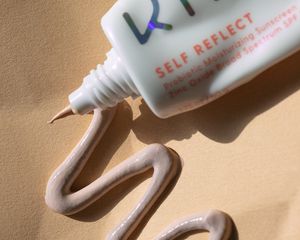
Sergey Filimonov/Stocksy
You (hopefully) already know the importance of using sunscreen every single day, not only to protect your skin from getting sunburned, but also to ward off skin cancer and other damage. You also are likely aware that the sun's UV rays can do some serious damage to your hair, causing both dryness and color fading.
But as if all of that weren't enough to worry about, there's another part of your body that's also susceptible to sun damage—your eyes. Exposure to UV light can cause a condition known as photokeratitis, which, at the risk of oversimplifying things, can basically be thought of as sunburned eyes. (And yes, that's as painful as it sounds.)
Ahead, board-certified ophthalmologists Noor Amra, MD and Diane Hilal-Campo, MD explained all the key information about photokeratitis. Keep reading to learn all about the condition and, more importantly, how to prevent it from happening in the first place.
Meet the Expert
- Noor Amra, MD, is a board-certified ophthalmologist at Advanced Eye Medical Group in Mission Viejo, California.
- Diane Hilal-Campo, MD, is a board-certified ophthalmologist in Oakland, New Jersey. She is the founder of Twenty/Twenty Beauty, a line of gentle eye makeup products and at-home treatments.
What Is Photokeratitis?
"Photokeratitis is an eye condition that occurs when UV light damages the surface of the cornea, the clear part of the eye covering your iris and pupil, and the conjunctiva, the tissue covering the whites of your eyes and the insides of your eyelids," Hilal-Campo explains. It's also known as ultraviolet keratitis, and it's often appropriate to describe it as a sunburn of the eyes, Amra adds.
Like a sunburn on the skin, photokeratitis can be very painful and uncomfortable. Symptoms can include intense eye pain, redness, light sensitivity, blurred vision, tearing, and a sensation of having a foreign body in the eyes, Amra says. Headaches, seeing halos around lights, and even temporary vision loss are also possible.
What Causes Photokeratitis?
Simply put, your eyes can get photokeratitis from the sun, through either direct or indirect exposure to UV rays. "More commonly it's the latter, because thankfully most of us don't spend time staring directly into the sun," Amra says. "Indirect UV exposure most often comes from reflections off of snow, ice, sand, and water." In fact, there's even an intense version of photokeratitis known as snow blindness, during which both UV rays and cold temperatures contribute to damage of the ocular surface.
Given that our eyes are always being exposed to some amount of UV light, it's important to note that photokeratitis is a result of prolonged, extreme exposure, usually six to 12 hours worth, Hilal-Campo says. It's also more likely to occur in areas with a higher UV light index, such as mountains and places closer to the equator, according to Amra. TL;DR: You're probably not going to develop sunburned eyes just from spending an hour outside, even on a super sunny day.
As far as direct exposure goes, one of the most well-known causes of photokeratitis is staring at the sun during a solar eclipse. Hilal-Campo says this can also cause more serious problems, including a retinal burn and even permanent vision loss. Both of our experts also point out that, along with the sun, exposure to man-made UV sources—tanning beds, sun lamps, laser light, and arc welding light—can also cause photokeratitis.
It's worth mentioning that, like a sunburn on the skin, the symptoms of photokeratitis often have a delayed onset—anywhere from six to up to 12 hours after exposure, according to Amra and Hilal-Campo. Plus, "the severity of the photokeratitis, just like the severity of the sunburn, is related to the duration and amount of UV sun exposure," Hilal-Campo notes.
Another similarity between photokeratitis and skin sunburn: "Lighter eyes, just like lighter skin tones, are more susceptible to sun damage due to naturally lower level of melanin," she says. That's why it's especially important fore people with blue, gray, or green eyes to wear sunglasses, although it's something everyone should be doing. (More on that point in a moment.)
How Can You Treat Photokeratitis?
The good news: "In most cases, the symptoms of photokeratitis are temporary and usually resolve on their own within a few days," Amra says. You can't really do anything to actually treat the condition in the meantime, but there are things you can do to help alleviate some of the uncomfortable symptoms. Removing contact lenses (if you wear them) and staying in a dark room is helpful, as is applying a cold washcloth over your sunburned eyes and/or using lubricating eye drops.
How Can You Prevent Photokeratitis?
While photokeratitis typically does go away on its own fairly quickly, constant UV exposure can lead to more serious issues, such as retinal burns, as well as increase your risk of developing certain eye cancers, cataracts, and macular degeneration, according to Amra. Point being, shielding your eyes from the sun is just as important as protecting your skin.
The easiest way to do so? Wear a good pair of sunglasses. Hilal-Campo recommends looking for sunnies that are marked as UV 400, meaning they block 100% of both UVA and UVB rays, as well as wrap-around styles for more complete protection. "Wearing a wide-brimmed hat or sun visor will also give you an extra layer of protection, especially if your sunglasses frame is smaller or doesn't have side panels," Amra adds.
The Final Takeaway
Photokeratitis can be extremely painful and uncomfortable, though it usually does resolve quickly. Along with never staring directly at the sun, sporting sunglasses—particularly if you're going to be outdoors in areas with lots of sun reflection for a prolonged period of time—is the best way to prevent the condition.
















